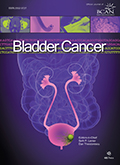Authors: Singh, Parminder | Ballas, Leslie | Sonpavde, Guru P. | Chen, Ronald C. | Bangs, Rick | Bauman, Brian C. | Nagar, Himanshu | Delacroix, Scott E. | Lerner, Seth P. | Efstathiou, Jason A.
Article Type:
Position Paper
Abstract:
BACKGROUND: Trimodality therapy (TMT) is a viable option for muscle-invasive localized bladder cancer, providing an alternative to radical cystectomy in properly selected patients. The approval of novel therapeutics in different stages of bladder cancer treatment has sparked interest in exploring concurrent systemic therapies with radiation in clinical trials to enhance long-term outcomes. Achieving uniformity in trial eligibility criteria and endpoint definitions is imperative in describing clinical significance, comparing trials, and changing standard of care guidelines. OBJECTIVE: To delineate eligibility criteria and appropriate endpoints for TMT clinical trials in an attempt to achieve uniformity in trial eligibility criteria and
…endpoint definitions which will then help move the field of bladder preservation forward and improve the current standard of care. METHODS: An expert panel, comprising individuals with extensive experience in bladder cancer clinical trials, clinical practice focused on bladder cancer treatment, and patient advocacy, was assembled. The panel systematically reviewed phase II/III clinical trials previously published and assessing the role of radiation in definitive therapy with the specific goal of preserving native bladder function during bladder cancer treatment. Recommendations were summarized based on review of these trials and past experiences of the investigators. To ensure a holistic perspective, the summary was further subjected to rigorous reevaluation by a patient advocate, who added valuable insights from a patient’s standpoint. The resulting consensus statements were summarized in this publication to contribute to the evolving landscape of bladder cancer research and treatment. RESULTS: The eligibility criteria for TMT should be pragmatic to encompass patients with an Eastern Cooperative Oncology Group (ECOG) performance status of 0-2, bladder cancer stage T2-T4a N0±N1M0, unilateral tumor-associated hydronephrosis, attempted maximal transurethral resection of bladder tumor (TURBT), both pure urothelial carcinoma and/or mixed histologic subtypes (excluding rare and aggressive small cell variants) and patients who are non- cystectomy candidates. Bladder intact event-free survival (BIEFS) is proposed as a suitable endpoint for registration trials designed to compare two different treatment interventions, defined as the time from randomization to muscle-invasive or locoregional recurrence, systemic recurrence, radical cystectomy from any cause, or death from any cause. Overall survival is deemed an appropriate secondary endpoint or a co-primary end point as recent improvements in systemic therapy can produce significant improvement in long-term outcomes. Primary and secondary endpoints should be supported with patient-reported quality of life assessments, when available. CONCLUSIONS: The standardization of clinical trial design, eligibility criteria, and endpoints is essential for expediting progress in the field. Inclusivity, patient-centricity, and clinically meaningful endpoints will facilitate the analysis, comparison, and meta-analysis of different trials, fostering advancements in bladder cancer treatment.
Show more
Keywords: Bladder cancer, trimodality therapy
DOI: 10.3233/BLC-240036
Citation: Bladder Cancer,
vol. 10, no. 3, pp. 199-213, 2024





